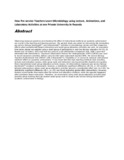How Pre-service Teachers Learn Microbiology using Lecture, Animations, and Laboratory Activities at one Private University in Rwanda
Date
2021-07-31Author
Mukagihana, Josiane
Nsanganwimana, Florien
Aurah, Catherin M.
Metadata
Show full item recordAbstract
Observing classroom practices and checking the effect of instructional methods on academic achievement are crucial in the teaching and learning process. The present study was aimed at discovering the dominating pre-service biology teachers’ and instructors’ activities in microbiology classes and their respective effects when animations–based instructions and small-group laboratory activities are used. An equivalent time-series design was applied using a small group of participants in year two biology education (N=30, 16 female and 14 males), and a pre-test was used as a pre-intervention comparison test, while a post-test alternated with interventions. Classroom Observation Protocol for Undergraduate STEM (COPUS) was used to record classroom activities. Before using its inter-rater agreement reached 80%. Pre-service Biology Teachers Achievement Test (PBTAT) with a Pearson’s r reliability of .51 served to measure instructional methods' effect on academic achievement. It was found that the main teaching methods were activities, lectures and animation classes, while group work and instructors moving among the students and guiding them characterized small-group laboratory activity classes. All interventions improved pre-service biology teachers’ academic achievement; however, a statistically significant difference (df=28, p<.05) existed between interventions where small group laboratory activities proved a considerable effect size (d=3.86). No statistically significant difference (df=1, p>.05) was found regarding gender after interventions. However, females scored better than males after the lecture and laboratory methods, while the opposite happened after animation-based instruction. Therefore, we recommend using small-group laboratory activities that promote active learning through student small-group work to improve pre-service biology teachers’ academic achievement in biology.
URI
https://doi.org/10.26803/ijlter.20.7.18https://www.ijlter.org/index.php/ijlter/article/view/3869
http://ir-library.mmust.ac.ke:8080/xmlui/handle/123456789/1797
Collections
- Gold Collection [1026]

